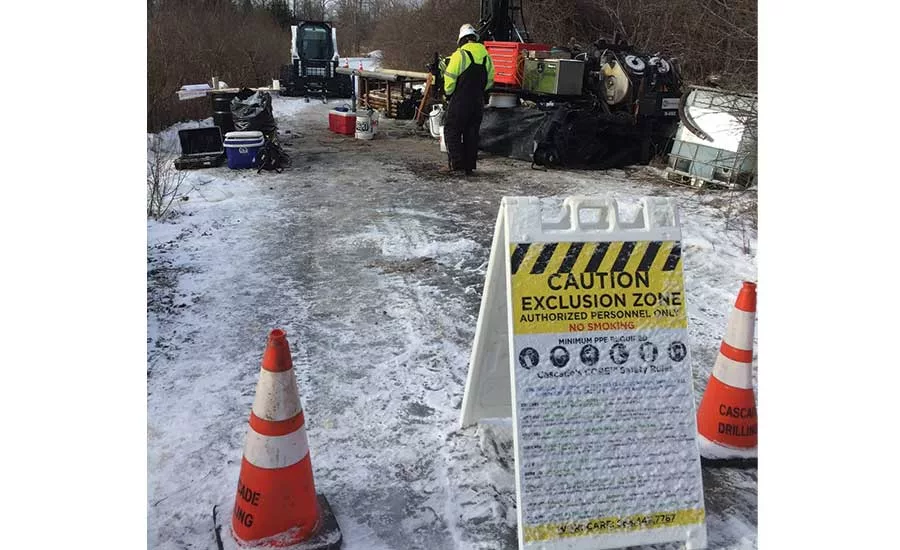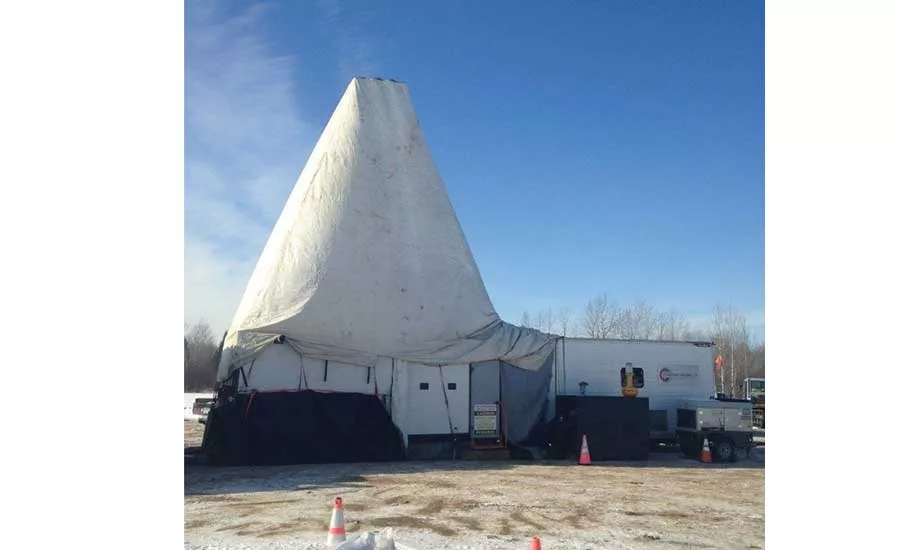Health & Safety Tips for Cold Weather Drilling Sites

Dale Duscher is Cascade’s Great Lakes regional safety manager. He is a dedicated safety and compliance professional, and certified MSHA and LPS (Loss Prevention System) trainer, with over 30 years’ experience in the drilling industry.

From PPE to fleet maintenance, temperature and weather conditions can affect all aspects of drilling jobs in winter months. Source: Cascade Environmental

For longer-term jobs during cold months, a tent can guard crews and gear against the worst weather conditions. Source: Cascade Environmental
Drilling in cold weather environments presents unique health and safety challenges. Simple precautions and slight modifications of the operational routine can keep crews productive and free from injury as the temperataure drops.
Rig breakdowns, lost production and tooling failure are just a few examples of the problems brought on by cold weather. Let’s take look at the three most important aspects of cold weather preparedness, along with some specific health and safety tips for cold weather drilling sites.
Vehicles and Equipment
Vehicles and other equipment are one of the first things noticeably affected by cold weather. This creates some serious challenges on environmental drilling sites as the work depends on these assets. The falling temperatures subject the fleet to additional stress which may lead to breakdowns, lost production and potential safety hazards.
Here are some preventative tips to help ensure that jobsite vehicles operate as needed:
- Increase engine service intervals during the winter months if your equipment runs idle for longer periods of time.
- Choose lighter hydraulic oils, preferably synthetic. These oils move through a cold system more easily, saving wear and tear on pumps and valves.
- If you are running diesel engines, start using additives, like Power Service, to remove moisture and prevent gelling.
- Change fuel filters at every oil change and keep tanks full to prevent moisture buildup.
- Check tire pressure, especially in the steer tires, often as it can drop 1 PSI for every 10-degree drop in temperature. Driving on low tires is both dangerous and less fuel efficient.
- Check the date and condition of the batteries. If they are old and in bad shape, replace them.
- Carry a good set of jumper cables that are constructed of 4-gauge cable or heavier; 2-gauge is ideal.
Personal Protective Equipment (PPE)
Conventional PPE is crucial for drilling crews working outside in colder weather. Hypothermia, frostbite, slips and other accidents can all be easily prevented with adequate preparation.
Here are a few tips to be properly prepared on a cold weather jobsite:
- Avoid one-piece coveralls as they restrict movement and can encumber crews.
- Wear the right gloves for the environmental and work conditions. There are a variety of gloves available, in a variety of sizes. Crews should rotate gloves often, making sure to always have a dry pair.
- Wear cut-resistant liners under winter gloves instead of cut-resistant winter gloves. Liners have better dexterity, are higher quality, are more cost efficient and are available in a wider variety.
- Wear boots with good traction to prevent slips, trips and falls. In some cases, ice cleats are needed as well.
- Hooded sweatshirts are great for warmth, but keep in mind potential hazards associated with the hood. Wearing ear muffs over a hooded sweatshirt reduces the effectiveness of the hearing protection. Consider wearing ear plugs along with ear muffs as an alternative. Detachable hoods provide an additional layer of protection around rotating parts.
Jobsite Travel
Traveling in the winter is often hazardous. These tips are essential for the jobsite commute:
- Plan trips using main roads wherever possible. High traffic roadways are more frequently plowed and maintained.
- Communicate your estimated arrival time to co-workers and other jobsite personnel. Check in with them if you are running late.
- Drive at slower speeds to accommodate for weather conditions and allow for extra commuting time.
- Offer drivers winter driving classes such as Smith Defensive Driving.
- Use extra caution when driving in low-light and dark conditions. Winter months are darker, especially at the beginning and end of the day.
- Remember that other drivers are experiencing similar hazards, so approach intersections with care.
- Keep your windshield clean and carry a small spray bottle of washer fluid to use if the sprayers on your vehicle are frozen.
- In many parts of the U.S., deer activity is increased this time of year. Over 1.5 million deer accidents occur every year. It may seem counterintuitive, but the rule of thumb is to always continue straight, whether you hit the deer or not. Swerving to avoid it will cause you to drive off the road or into oncoming traffic.
- Utilize anti-lock brake features and four-wheel drive if vehicles are equipped with them.
- Stock emergency items in the vehicle like a flashlight and batteries, blankets, gloves, heating packs, food and water to keep you safe and warm should the vehicle become disabled.
A Real Example from Cascade Environmental
One of our complex jobsites in northern Minnesota is a perfect example of planning and preparation. This job involves elaborate mud systems and deep holes in excess of 2,000 feet with temperatures that regularly stay below zero for weeks at a time. A job of this type requires the drill to operate 24 hours a day.
To handle the extreme climate, a full drill and tooling enclosure was fabricated. Heated tower socks and portable tooling trailers protect the equipment from the harsh elements. All drivers are required to complete winter driving training and all ETA times are communicated between night shifts and day shifts. Mandatory check-ins are also required when the crew arrives at the motel safely. Regular maintenance is performed in the field on all drill rigs, generators and light plants. A large selection of spare parts is kept on hand, including extra PPE, belts, batteries, fuel filters, hydraulic hoses and pumps, and other common wear parts. The planning and preparation with the extreme weather conditions in mind allows us to drill successfully in even the harshest climates, 24 hours a day.
Looking for a reprint of this article?
From high-res PDFs to custom plaques, order your copy today!


